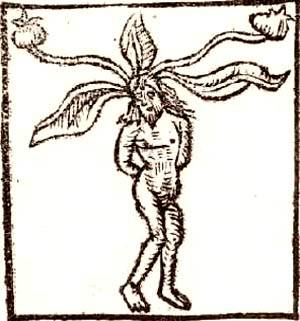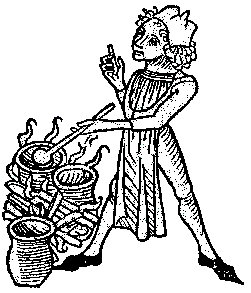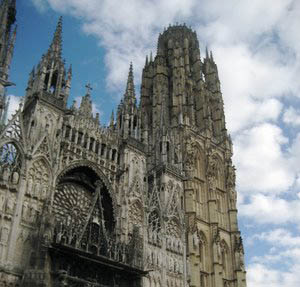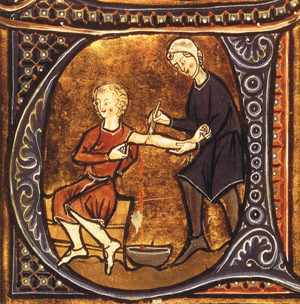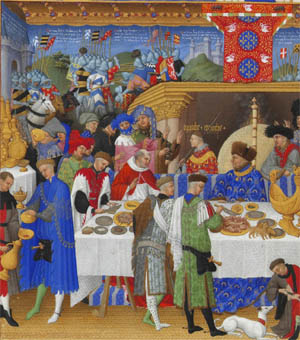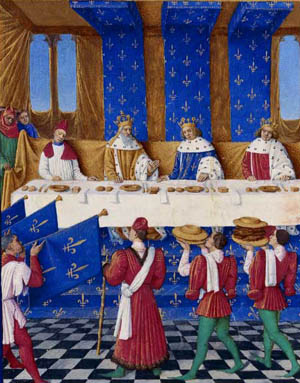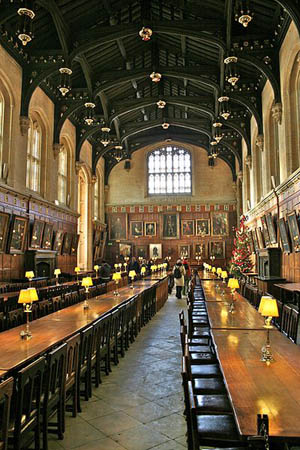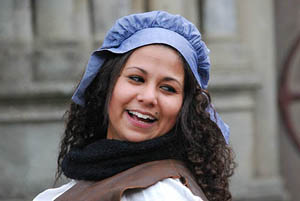Life In A Medieval Castle
|
|
|
|||||||||||||||||||||
Medieval Food & Cooking
Feasting and enjoying food was an important part of medieval life, because during a war there wasn't very much to eat. Nobles had to pay for food and wages for his household. Bread was the basic food in the Middle Ages, it could be made with barley, rye, and wheat. Wealthy people used thick slices of brown bread as bowls called trenchers to soak up juice and sauce from the food. Flour made for the castle was ground at the lord's own mill by his miller. Millers produced different kinds of flour, fine, to make white bread for the king or lord, and brown bread for the servants. Birds like chickens, geese, and ducks were keptr. On special occasions the wealthy ate swan and peacock. Beef and venison were well liked, so was pork. Mustard was a favorite ingredient. Medieval people liked fish and fresh meat that was not salted yet. Meat was salted in huge wooden vats so that the food would not spoil. Salt was expensive but large quantities were bought every year. Most people ate with their fingers and their own knives; forks were introduced towards the end of the Middle Ages. Many people thought forks were silly, but every one had to behave properly at mealtime. There were many rules on the correct way to eat and where people sat at the table. Before 1100 honey was the only way to sweeten food because spices were expensive because they came from the Far East. Herbs were used to season food and make remedies for the ill. Crusaders brought new foods like raisins, dates, and figs to Europe. Cereals remained the most important staples during the early Middle Ages, as rice was a late introduction to Europe and the potato was only introduced in 1536 (and for centuries was used almost exclusively to feed animals). Barley, oat and rye among the poor, and wheat for the governing classes, were eaten as bread, porridge, gruel and pasta by all members of society. Fava beans and vegetables were important supplements to the cereal-based diet of the lower orders. Meat was more expensive and therefore more prestigious and in the form of game was common only on the tables of the nobility and poachers. The most prevalent butcher's meats were pork and chicken and other domestic fowl. Beef, which required greater investment in land, was less common. Cod and herring were mainstays among the northern populations, and dried, smoked or salted made their way far inland. A wide variety of other saltwater and freshwater fish were also eaten - castles generally had their own fishponds. Slow transportation and inefficient food preservation techniques,(drying, salting, smoking and pickling) made long-distance trade of many foods expensive. Because of this, the food of the nobility was more prone to foreign influence than the cuisine of the poor, and dependent on exotic spices and expensive imports. As each level of society imitated the one above it, innovations from international trade and foreign wars from the 12th century onwards gradually disseminated through the upper middle class of medieval cities. Aside from economic unavailability of luxuries such as spices, decrees outlawed consumption of certain foods among certain social classes, Sumptuary laws limited the conspicuous consumption among the nouveau riche. Social norms also dictated that the food of the working class be less refined, since it was believed there was a natural resemblance between one's labor and one's food, so manual labor required coarser, cheaper food. A type of refined cooking developed in the late Middle Ages that set the standard among the nobility all over Europe. Common seasonings in the highly spiced sweet-sour repertory typical of upper-class medieval food included verjuice, wine and vinegar in combination with spices such as black pepper, saffron and ginger. These, along with the widespread use of sugar or honey gave many dishes a sweet-sour flavor. Almonds were very popular as a thickener in soups, stews, and sauces, particularly as almond milk. 
The cuisines of the cultures of the Mediterranean Basin had since antiquity been based on cereals, particularly various types of wheat. Porridge and gruel, and later bread became the basic food staple that made up the majority of calorie intake for most of the population. From the 8th to the 11th centuries, the proportion of various cereals of the diet rose from about 1⁄3 to 3⁄4. Dependence on wheat remained significant throughout the medieval era, and spread northwards. In colder climates, wheat was usually unaffordable for most people, and was associated with the higher classes. The centrality of bread in religious rituals such as the Eucharist meant that it enjoyed an especially high prestige among foodstuffs. Only olive oil and wine had a comparable value, but both remained exclusive outside of the warmer wine- and olive-growing regions. In the British Isles, northern France, the Low Countries, the northern German-speaking areas, Scandinavia and the Baltic the climate was generally too harsh for the cultivation of grapes and olives. In the south, wine was the common drink for both rich and poor alike (though the commoner usually had to settle for cheap second pressing wine) while beer was the commoner's drink in the north and wine an expensive import. Citrus fruits (though not the kinds most common today) and pomegranates were common around in the Mediterranean. Dried figs and dates occurred in the north, but were used rather sparingly in cooking. Olive oil was a ubiquitous ingredient around the Mediterranean, but remained an expensive import in the north where oil of poppy, walnut, hazel and filbert was the most affordable alternative. Butter and lard, especially after the terrible mortality during the Black Death, was used in considerable quantities in the northern and northwestern regions. Food
|
|
||||||||||||||||||||
|
|
|
|||||||||||||||||||
|
|||||||||||||||||||||
|
|
|||||||||||||||||||||
Food preparationAll types of cooking involved the use of open fires. Stoves did not appear until the 18th century, and cooks had to know how to cook directly over an open fire. Ovens were used, but they were expensive to construct and only existed in fairly large households and bakeries. Castles, of course would have their own ovens - often several different ones. Outside of castles it was common for a community to have shared ownership of an oven to ensure that the bread baking essential to everyone was made communal rather than private. There were also portable ovens designed to be filled with food and then buried in hot coals, and even larger ones on wheels that were used to sell pies in the streets of medieval towns. Almost all cooking was done in simple stewpots, since this was the most efficient use of firewood and did not waste precious cooking juices, making potages and stews the most common dishes. Overall, most evidence suggests that medieval dishes had a fairly high fat content, or at least when fat could be afforded. This was considered less of a problem in a time of back-breaking toil, famine, and a greater acceptance, even desirability, of plumpness; only the poor or sick, and devout ascetics, were thin. Fruit was readily combined with meat, fish and eggs. It was considered important to make sure that the dish agreed with contemporary standards of medicine and dietetics. This meant that food had to be "tempered" according to its nature by an appropriate combination of preparation and mixing certain ingredients, condiments and spices; fish was seen as being cold and moist, and best cooked in a way that heated and dried it, such as frying or oven baking, and seasoned with hot and dry spices; beef was dry and hot and should therefore be boiled; pork was hot and moist and should therefore always be roasted. In some recipe collections, alternative ingredients were assigned with more consideration to the humoral nature than what a modern cook would consider to be similarity in taste. In a recipe for quince pie, cabbage is said to work equally well, and in another turnips could be replaced by pears. The completely edible shortcrust pie did not appear in recipes until the 15th century. Before that the pastry was primarily used as a cooking container in a technique known as 'huff paste' . Recipe collections show that gastronomy in the Late Middle Ages developed significantly. New techniques, like the shortcrust pie and the clarification of jelly with egg whites began to appear in recipes in the late 14th century and recipes began to include detailed instructions instead of being mere memory aids to an already skilled cook.
|
|
||||||||||||||||||||
CerealsThe period between c. 500 and 1300 saw a major change in diet that affected most of Europe. More intense agriculture on an ever-increasing acreage resulted in a shift from animal products, meat and dairy products to various grains and vegetables as the staple of the majority population. Before the 14th century bread was not as common among the lower classes, especially in the north where wheat was more difficult to grow. A bread-based diet became gradually more common during the 15th century and replaced warm intermediate meals that were porridge- or gruel-based. Leavened bread was more common in wheat-growing regions in the south, while unleavened flatbread of barley, rye or oats remained more common in northern and highland regions, and unleavened flatbread was also common as provisions for troops. The most common grains were rye, barley, buckwheat, millet, and oats. Rice remained a fairly expensive import for most of the Middle Ages and was grown in northern Italy only towards the end of the period. Wheat was common all over Europe and was considered to be the most nutritious of all grains, but was more prestigious and thus more expensive. The finely sifted white flour that modern Europeans are most familiar with was reserved for the bread of the upper classes. As one descended the social ladder, bread became coarser, darker, and its bran content increased. In times of grain shortages or outright famine, grains could be supplemented with cheaper and less desirable substitutes like chestnuts, dried legumes, acorns, ferns, and a wide variety of more or less nutritious vegetable matter. One of the most common constituents of a medieval meal, either as part of a banquet or as a small snack, were sops, pieces of bread with which a liquid like wine, soup, broth, or sauce could be soaked up and eaten. Another common sight at the medieval dinner table was the frumenty, a thick wheat porridge often boiled in a meat broth and seasoned with spices. Porridges were also made of every type of grain and could be served as desserts or dishes for the sick, if boiled in milk (or almond milk) and sweetened with sugar. Pies filled with meats, eggs, vegetables, or fruit were common throughout Europe, as were turnovers, fritters, doughnuts, and many similar pastries. By the Late Middle Ages biscuits and especially wafers, eaten for dessert, had become high-prestige foods and came in many varieties. Grain, either as bread crumbs or flour, was also the most common thickener of soups and stews, alone or in combination with almond milk.
|
|
||||||||||||||||||||
|
|
|
||||||||||||||||||||
|
|
|||||||||||||||||||||
Fruit
Fruit was popular and could be served fresh, dried, or preserved, and was a common ingredient in many cooked dishes.[ Since sugar and honey were both expensive, it was common to include many types of fruit in dishes that called for sweeteners of some sort. The fruits of choice in the south were lemons, citrons, bitter oranges (the sweet type was not introduced until several hundred years later), pomegranates, quinces, and, of course, grapes. Further north, apples, pears, plums, and strawberries were more common. figs and dates were eaten all over Europe, but remained rather expensive imports in the north.
|
|
||||||||||||||||||||
Vegetables
Vegetables such as cabbage, beets, onions, garlic and carrots were common foodstuffs. Many of these were eaten daily by peasants and workers, but were less prestigious than meat. Cookbooks, intended mostly for those who could afford such luxuries, which appeared in the late Middle Ages, only contained a small number of recipes using vegetables as the main ingredient. The lack of recipes for many basic vegetable dishes, such as potages, has been interpreted not to mean that they were absent from the meals of the nobility, but rather that they were considered so basic that they did not require recording. Carrots were available in many variants during the Middle Ages: among them a tastier reddish-purple variety and a less prestigious green-yellow type. Various legumes, like chickpeas, fava beans and peas were also common and important sources of protein, especially among the lower classes. With the exception of peas, legumes were often viewed with some suspicion by the dietitians advising the upper class, partly because of their tendency to cause flatulence but also because they were associated with the coarse food of peasants. Common and often basic ingredients in many modern European cuisines like potatoes, kidney beans, cacao, vanilla, tomatoes, chili peppers and maize were not available to Europeans until the late 15th century after European contact with the Americas, and even then it often took a long time for the new foodstuffs to be accepted by society at large. |
|
||||||||||||||||||||
Fish and SeafoodAlthough less prestigious than other animal meats, and often seen as merely an alternative to meat on fast days, seafood was the mainstay of many coastal populations. "Fish" to the medieval person was also a general name for anything not considered a proper land-living animal, including marine mammals such as whales and porpoises. Also included were the beaver, due to its scaly tail and considerable time spent in water, and barnacle geese, due to lack of knowledge of where they migrated. Such foods were also considered appropriate for fast days. Especially important was the fishing and trade in herring and cod in the Atlantic and the Baltic Sea. The herring was of unprecedented significance to the economy of much of Northern Europe, and it was one of the most common commodities traded by the Hanseatic League. Kippers made from herring caught in the North Sea could be found in markets as far away as Constantinople. While large quantities of fish were eaten fresh, a large proportion was salted, dried, and, to a lesser extent, smoked. Stockfish, cod that was split down the middle, fixed to a pole and dried, was very common, though preparation could be time-consuming, and meant beating the dried fish with a mallet before soaking it in water. A wide range of molluscs including oysters, mussels and scallops were eaten by coastal and river-dwelling populations, and freshwater crayfish were seen as a desirable alternative to meat during fish days. Compared to meat, fish was much more expensive for inland populations, especially in Central Europe, and therefore not an option for most. Freshwater fish such as pike, carp, bream, perch, lamprey, and trout were common.
|
|
||||||||||||||||||||
MeatWild game were popular among those who could obtain it, but most meat came from domesticated animals. Beef was not as common as today because raising cattle was labor-intensive, requiring pastures and feed, and oxen and cows were much more valuable as draught animals and for producing milk. Animals slaughtered because they were no longer able to work were not particularly appetizing and were therefore less valued. Far more common was pork, as pigs required less attention and cheaper feed. Domestic pigs often ran freely even in towns and could be fed on just about any organic kitchen waste, and suckling pig was a sought-after delicacy. Mutton and lamb were fairly common, especially in areas with a sizeable wool industry, as was veal. Every part of the animal was eaten, including ears, snout, tail, tongue, and womb. Intestines, bladder and stomach could be used as casings for sausage or even illusion food such as giant eggs. Among the meats that today are rare or even considered inappropriate for human consumption the hedgehog and porcupine, occasionally mentioned in late medieval recipe collections. A wide range of birds was eaten, including swans, peafowl, quail, partridge, storks, cranes, larks, linnets and other songbirds that could be trapped in nets, and just about any other wild bird that could be hunted. Swans and peafowl were domesticated to some extent, but were only eaten by the social elite, and more praised for their fine appearance as stunning entertainment dishes, entremets, than for their meat. 
Geese and ducks had been domesticated but were not as popular as the chicken, the fowl equivalent of the pig. Meats were more expensive than plant foods. Though rich in protein, the calorie-to-weight ratio of meat was less than that of plant food. Meat could be up to four times as expensive as bread. Fish was up to 16 times as costly, and was still expensive even for coastal populations. This meant that fasts could mean an especially meager diet for those who could not afford alternatives to meat and animal products like milk and eggs. It was only after the Black Death had eradicated up to half of the European population that meat became more common even for poorer people. The drastic reduction in many populated areas resulted in a labor shortage, meaning that wages shot up. It also left vast areas of farmland untended, making them available for pasture and putting more meat on the market. |
|
||||||||||||||||||||
|
|
|||||||||||||||||||||
Dairy productsMilk was an important source of animal protein for those who could not afford meat. It would mostly come from cows, but milk from goats and sheep was also common. Plain fresh milk was not consumed by adults except the poor or sick, and was usually reserved for the very young or elderly.
Cheese was far more important as a foodstuff, especially for common people, and it has been suggested that it was, during many periods, the chief supplier of animal protein among the lower classes. Many varieties of cheese eaten today, like Dutch Edam, Northern French Brie and Italian Parmesan, were available and well-known in late medieval times. There were also whey cheeses, like ricotta, made from by-products of the production of harder cheeses. Cheese was used in cooking for pies and soups, the latter being common fare in German-speaking areas. Butter, another important dairy product, was in popular use in the regions of Northern Europe that specialized in cattle production in the latter half of the Middle Ages, the Low Countries and Southern Scandinavia. While most other regions used oil or lard as cooking fats, butter was the dominant cooking medium in these areas. Its production also allowed for a lucrative butter export from the 12th century onward. |
|
||||||||||||||||||||
Herbs & SpicesSpices were among the most luxurious products available in the Middle Ages, the most common being black pepper, cinnamon (and the cheaper alternative cassia), cumin, nutmeg, ginger and cloves. They all had to be imported from plantations in Asia and Africa, which made them extremely expensive, and gave them social cachet such that pepper for example was hoarded, traded and conspicuously donated in the manner of gold bullion. It has been estimated that around 1,000 tons of pepper and 1,000 tons of the other common spices were imported into Western Europe each year during the late Middle Ages. The value of these goods was the equivalent of a yearly supply of grain for 1.5 million people. While pepper was the most common spice, the most exclusive, though not the most obscure in its origin, was saffron, used as much for its vivid yellow-red color as for its flavor, for according to the humours, yellow signified hot and dry, valued qualities; turmeric provided a yellow substitute, and touches of gilding at banquets supplied both the medieval love of ostentatious show and Galenic dietary lore: at the sumptuous banquet that Cardinal Riario offered the daughter of the King of Naples in June 1473, the bread was gilded.[ Among the spices that have now fallen into obscurity are grains of paradise, a relative of cardamom which almost entirely replaced pepper in late medieval north French cooking, long pepper, mace, spikenard, galangal and cubeb. Sugar, unlike today, was considered to be a type of spice due to its high cost and humoral qualities.[ Few dishes employed just one type of spice or herb, but rather a combination of several different ones. Even when a dish was dominated by a single flavorer it was usually combined with another to produce a compound taste, for example parsley and cloves or pepper and ginger. Common herbs such as sage, mustard, and parsley were grown and used in cooking all over Europe, as were caraway, mint, dill and fennel. Many of these plants grew throughout all of Europe or were cultivated in gardens, and were a cheaper alternative to exotic spices. Mustard was particularly popular with meat products and was described by Hildegard of Bingen (1098–1179) as poor man's food. While locally grown herbs were less prestigious than spices, they were still used in upper-class food, but were then usually less prominent or included merely as coloring. Anise was used to flavor fish and chicken dishes, and its seeds were served as sugar-coated comfits. Surviving medieval recipes frequently call for flavoring with a number of sour, tart liquids. Wine, verjuice (the juice of unripe grapes or fruits) vinegar and the juices of various fruits, especially one those with tart flavors were almost universal and a hallmark of late medieval cooking. In combination with sweeteners and spices, it produced a distinctive "pungeant, fruity" flavor. Equally common, and used to complement the tanginess of these ingredients, were (sweet) almonds. They were used in a variety of ways: whole, shelled or unshelled, slivered, ground and, most importantly, processed into almond milk. This last type of non-dairy milk product is probably the single most common ingredient in late medieval cooking and blended the aroma of spices and sour liquids with a mild taste and creamy texture. Salt was a ubiquitous and indispensable in medieval cooking. Salting and drying was the most common form of food preservation and meant that especially fish and meat were often heavily salted. Many medieval recipes specifically warn against oversalting and there were recommendations for soaking certain products in water to get rid of excess salt. Salt was present during more elaborate or expensive meals. The richer the host, and the more prestigious the guest, the more elaborate would be the container in which it was served and the quality and price of the salt. Wealthy guests were provided with salt cellars made of pewter, precious metals or other fine materials, often intricately decorated. The rank of a diner also decided how finely ground and white the salt was. Salt for cooking, preservation or for use by common people was coarser; sea salt, or "bay salt", in particular, had more impurities, and was described in colors ranging from black to green. Expensive salt, on the other hand, looked like the standard commercial salt common today.
|
|
||||||||||||||||||||
Puddings ( Sweets and Desserts)The term "dessert" comes from the Old French desservir, "to clear a table", literally "to un-serve", and originated during the Middle Ages. It would typically consist of dragées and mulled wine accompanied by aged cheese, and by the Late Middle Ages could also include fresh fruit covered in sugar, honey or syrup and boiled-down fruit pastes. Sugar, from its first appearance in Europe, was viewed as much as a drug as a sweetener; its long-lived medieval reputation as an exotic luxury encouraged its appearance in elite contexts accompanying meats and other dishes that to modern taste are more naturally savoury. There was a wide variety of fritters, crêpes with sugar, sweet custards and darioles, almond milk and eggs in a pastry shell that could also include fruit and sometimes even bone marrow or fish. Marzipan in many forms was well-known in Italy and southern France by the 1340s and is assumed to be of Arab origin. Anglo-Norman cookbooks are full of recipes for sweet and savory custards, potages, sauces and tarts with strawberries, cherries, apples and plums. English chefs also had a penchant for using flower petals such as roses, violets, and elder flowers. An early form of quiche can be found in Forme of Cury, a 14th century recipe collection, as a Torte de Bry with a cheese and egg yolk filling. In northern France, a wide assortment of waffles and wafers was eaten with cheese and hypocras or a sweet malmsey as issue de table ("departure from the table"). The ever-present candied ginger, coriander, aniseed and other spices were referred to as épices de chambre ("parlor spices") and were taken as digestables at the end of a meal to "close" the stomach. Like their Muslim counterparts in Spain, the Arab conquerors of Sicily introduced a wide variety of new sweets and desserts that eventually found their way to the rest of Europe. Just like Montpellier, Sicily was once famous for its comfits, nougat candy (torrone, or turrón in Spanish) and almond clusters (confetti). From the south, the Arabs also brought the art of ice cream making that produced sorbet and several examples of sweet cakes and pastries; cassata alla Siciliana (from Arabic qas'ah, the term for the terra cotta bowl with which it was shaped), made from marzipan, sponge cake and sweetened ricotta and cannoli alla Siciliana, originally cappelli di turchi ("Turkish hats"), fried, chilled pastry tubes with a sweet cheese filling.
|
|
||||||||||||||||||||
Food PreservationEven if food was plentiful in the summer, it was rarely so in the winter. Food had to be preserved to carry people through to the next season of plenty. Also preserved food became even more important in times of siege. Food preservation methods were the same as had been used since antiquity (and did not change much until the invention of canning in the 19th century). The most common and simplest method was to expose foodstuffs to heat or wind to remove moisture, thereby prolonging the durability if not the flavour of almost any type of food from cereals to meats; the drying of food worked by drastically reducing the activity of various water-dependent microorganisms that cause decay. In warm climates this was mostly achieved by leaving food out in the sun, and in the cooler northern climates by exposure to strong winds (especially common for the preparation of stockfish), or in warm ovens, cellars, attics, and even in living quarters. Subjecting food to a number of chemical processes such as smoking, salting, brining, conserving or fermenting also made it keep longer. Most of these methods had the advantage of shorter preparation times and of introducing new flavors. Smoking or salting meat of livestock butchered in the fall was a common household strategy to avoid having to feed more animals than necessary during the lean winter months. Butter tended to be heavily salted (5–10%) in order not to spoil. Vegetables, eggs or fish were also often pickled in tightly packed jars, containing brine and acidic liquids (lemon juice, verjuice or vinegar). Another method was to create a seal around the food by cooking it in sugar or honey or fat, in which it was then stored. Bacterial modification was also encouraged, however, by a number of methods; grains, fruit and grapes were turned into alcoholic drinks thus killing any bacteria, and milk was fermented and cured into a multitude of cheeses or buttermilk.
|
|
||||||||||||||||||||
Influence of Church TeachingBoth Roman Catholic and Eastern Orthodox Churches exercised control on eating habits - most npotably through regulations about fasting. Consumption of meat was forbidden for a full third of the year for most Christians.All animal products, including eggs and dairy products (but not fish), were prohibited during Lent and on other fast days. Additionally, it was customary for Christians to fast prior to taking the Eucharist. In most of Europe, Wednesdays, Fridays, sometimes Saturdays and various other days on the calendar, including Advent, were fast days. During particularly severe fast days, the number of daily meals was also reduced to one. Even if most people respected these restrictions and usually made penance when they violated them, there were also numerous ways of circumventing the problem, a conflict of ideals and practice summarized by writer Bridget Ann Henisch: Although animal products were to be avoided during times of penance, people found ways to vary their diets. The definition of "fish" was extended to marine and semi-aquatic animals such as whales, barnacle geese, puffins and beavers. The choice of ingredients may have been limited, but that did not mean that meals were smaller. Neither were there any restrictions against (moderate) drinking or eating sweets. Banquets held on fish days could be splendid, and they were popular occasions for serving illusion food that imitated meat, cheese and eggs; fish could be molded to look like venison, ham or bacon. Almond milk replaced animal milk as an expensive non-dairy alternative;. Faux eggs made from fish roe and almond milk were cooked in blown-out eggshells, flavoored and colored with exclusive spices. While the poor were required to conform to the Church's rules, nobles and churchmen were not. Nobles could buy exceptions - many so caled "butter towers" around Europe were funded by selling excemptions from the requirement not eat dairy products. Monstic orders simply ignored therules for themselves, often justifying themselves by improbable interpretations of the Bible. Since the sick were exempt from fasting, there often evolved the notion that fasting restrictions did not apply in hospitals and this was extended to anywhere outside the refectory. Monk and Friars would simply eat their fast day meals outside the refectory. Food was an important marker of social status. According to Christian teaching of the time, society consisted of the three estates of the realm: nobility, clergy, and commoners - the working class. The relationship between the classes was strictly hierarchical, with the nobility and clergy claiming worldly and spiritual overlordship over commoners. In the late Middle Ages, the increasing wealth of middle class merchants and traders meant that commoners began emulating the aristocracy, and threatened to break down some of the symbolic barriers between the nobility and the lower classes. The response came in two forms: didactic literature warning of the dangers of adapting a diet inappropriate for one's class, and sumptuary laws that limited the lavishness of commoners' banquets. Moralists frowned on breaking the overnight fast ("breakfast") too early, and members of the Church, the nobility and cultivated gentry avoided it. For practical reasons, breakfast was still eaten by working men, and was tolerated for young children, women, the elderly and the sick. Because the church preached against gluttony and other weaknesses of the flesh, men tended to be ashamed of needing to eat additional meals. Lavish dinner banquets and late-night reresopers (from Occitan rèire-sopar, "late supper") with considerable amounts of alcoholic beverage were considered immoral. The latter were especially associated with gambling, crude language, drunkenness, and lewd behavior. Minor meals and snacks were common (although also discouraged by the church, and working men commonly received an allowance from their employers in order to buy nuncheons, small morsels to be eaten during breaks. |
|
||||||||||||||||||||
"Healthy" EatingMedical science of the Middle Ages had a considerable influence on what was considered healthy and nutritious among the upper classes. One's lifestyle including diet, exercise, appropriate social behaviour, and approved medical remedies was the way to good health, and all types of food were assigned certain properties that affected a person's health. All foodstuffs were also classified on scales ranging from hot to cold and moist to dry, according to the four bodily humors theory proposed by Galen that dominated Western medical science from late Antiquity until the 17th century. Medieval scholars considered human digestion to be a process similar to cooking. The processing of food in the stomach was seen as a continuation of the preparation initiated by the cook. In order for the food to be properly "cooked" and for the nutrients to be properly absorbed, it was important that the stomach be filled in an appropriate manner. Easily digestible foods would be consumed first, followed by gradually heavier dishes. If this regimen was not respected it was believed that heavy foods would sink to the bottom of the stomach, thus blocking the digestion duct, so that food would digest very slowly and cause putrefaction of the body and draw bad humors into the stomach. It was also of vital importance that food of differing properties not be mixed. Before a meal, the stomach would preferably be "opened" with an apéritif that was preferably of a hot and dry nature: confections made from sugar- or honey-coated spices like ginger, caraway and seeds of anise, fennel or cumin, wine and sweetened fortified milk drinks. A meal would ideally begin with easily digestible fruit, such as apples. It would then be followed by vegetables such as lettuce, cabbage, purslane, herbs, moist fruits, light meats, like chicken or goat kid, with potages and broths. After that came the "heavy" meats, such as pork and beef, as well as vegetables and nuts, including pears and chestnuts, both considered difficult to digest. It was popular, and recommended by medical expertise, to finish the meal with aged cheese and various digestives. The most ideal food was that which most closely matched the humor of human beings, i.e. moderately warm and moist. Food should preferably also be finely chopped, ground, pounded and strained to achieve a true mixture of all the ingredients. White wine was believed to be cooler than red and the same distinction was applied to red and white vinegar. Milk was moderately warm and moist, but the milk of different animals was believed to differ. Egg yolks were considered to be warm and moist while the whites were cold and moist. Skilled cooks were expected to conform to the regimen of humoral medicine. Even if this limited the combinations of food they could prepare, there was still ample room for artistic variation by the chef. As the stomach had been opened, it should then be "closed" at the end of the meal with the help of a digestive, most commonly a dragée, which during the Middle Ages consisted of lumps of spiced sugar, or hypocras, a wine flavored with fragrant spices, along with aged cheese.
|
|
||||||||||||||||||||
 |
|||||||||||||||||||||
Meals & EtiquetteIn Europe there were typically two meals a day: dinner at mid-day and a lighter supper in the evening. The two-meal system remained consistent throughout the late Middle Ages. Smaller intermediate meals were common, but became a matter of social status, as those who did not have to perform manual labor could go without them. As with almost every part of life, a medieval meal was generally a communal affair. The entire household, including servants, would eat together. To sneak off to enjoy private company was considered a haughty and inefficient egotism in a world where people depended very much on each other. In the 13th century, English bishop Robert Grosseteste advised the Countess of Lincoln: "forbid dinners and suppers out of hall, in secret and in private rooms, for from this arises waste and no honour to the lord and lady." He also recommended to watch that the servants not make off with leftovers to make merry at rere-suppers, rather than giving it as alms. Towards the end of the Middle Ages, the wealthy increasingly sought to escape this regime of stern collectivism. When possible, rich hosts retired with their consorts to private chambers where the meal could be enjoyed in greater exclusivity and privacy. Being invited to a lord's chambers was a great privilege and could be used as a way to reward friends and allies and to awe subordinates. It allowed lords to distance themselves further from the household and to enjoy more luxurious treats while serving inferior food to the rest of the household that still dined in the great hall. At major occasions and banquets the host and hostess dined in the great hall with the other diners, with multiple courses, luxurious spices.. Before the meal and between courses, shallow basins and linen towels were offered to guests so they could wash their hands, as cleanliness was emphasized. Social codes made it difficult for women to uphold the ideal of immaculate neatness and delicacy while enjoying a meal, so the wife of the host often dined in private with her entourage or ate very little at such feasts. She could then join dinner only after the potentially messy business of eating was done. Overall, fine dining was a predominantly male affair, and it was uncommon for anyone but the most honoured of guests to bring his wife or her ladies-in-waiting. The lower ranked were expected to help the higher, the younger to assist the elder, and men to spare women the risk of sullying dress and reputation by having to handle food in an unwomanly fashion. Shared drinking cups were common even at lavish banquets for all but those who sat at the high table, as was the standard etiquette of breaking bread and carving meat for one's fellow diners. Food was mostly served on plates or in stew pots, and diners would take their share from the dishes and place it on trenchers of stale bread, or plates of wood or pewter with the help of spoons or bare hands.( In lower-class households it was common to eat food straight off the table). Knives were used at the table, but most people were expected to bring their own, and only highly favored guests would be given a personal knife. A knife was usually shared with at least one other dinner guest, unless one was of very high rank or well-acquainted with the host. Forks for eating were not in widespread usage in Europe until the early modern period, and early on were limited to Italy. Even there it was not until the 14th century that the fork became common among Italians of all social classes. The change in attitudes can be illustrated by the reactions to the table manners of the Byzantine princess Theodora Doukaina in the late 11th century. She was the future wife of the Doge of Venice, Domenico Selvo, and caused considerable dismay among upstanding Venetians. The foreign consort's insistence on having her food cut up by her eunuch servants and then eating the pieces with a golden fork shocked and upset the diners so much that the Bishop of Ostia later interpreted her refined foreign manners as pride and referred to her as "...the Venetian Doge's wife, whose body, after her excessive delicacy, entirely rotted away." |
|
||||||||||||||||||||
|
|
More on Life in a Medieval Castle
Introduction to Life in a Medieval Castle
Officers & Servants in a Medieval Castle
Mills: Windmills and Water Mills
|
|
|||||||||||||||||||
|
|
|
|
|||||||||||||||||||
|
|
|||||||||
| :::: Link to us :::: Castle and Manor Houses Resources ::: © C&MH 2010-2014 ::: contact@castlesandmanorhouses.com ::: Advertising ::: |
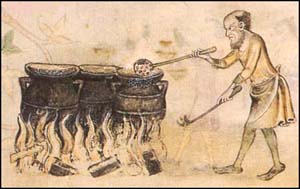
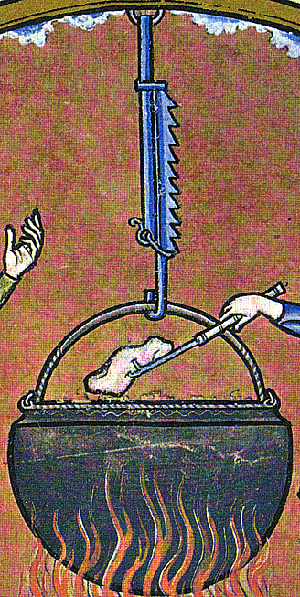
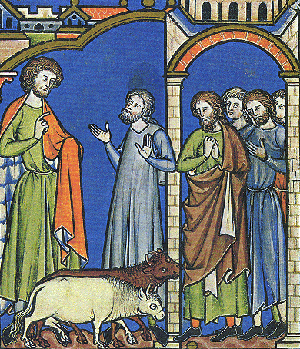
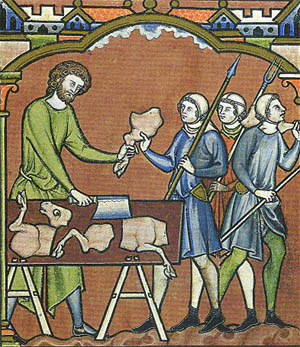

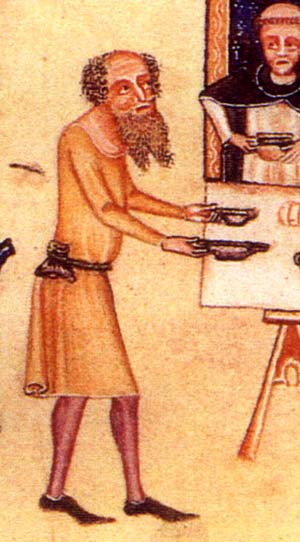

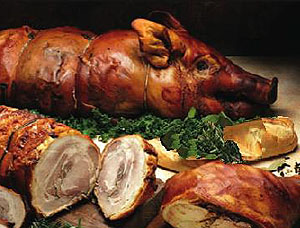
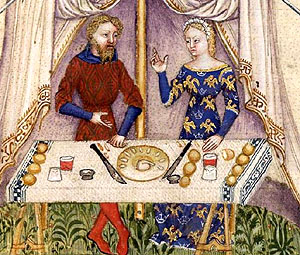








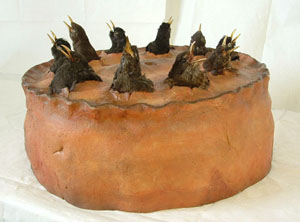

 Poor
adults would sometimes drink buttermilk or whey or milk that was
soured or watered down. Fresh milk was overall less common than
other dairy products because of the lack of technology to keep it
from spoiling. On occasion it was used in upper-class kitchens in
stews, but it was difficult to keep fresh in bulk and almond milk
was generally used in its stead.
Poor
adults would sometimes drink buttermilk or whey or milk that was
soured or watered down. Fresh milk was overall less common than
other dairy products because of the lack of technology to keep it
from spoiling. On occasion it was used in upper-class kitchens in
stews, but it was difficult to keep fresh in bulk and almond milk
was generally used in its stead.



